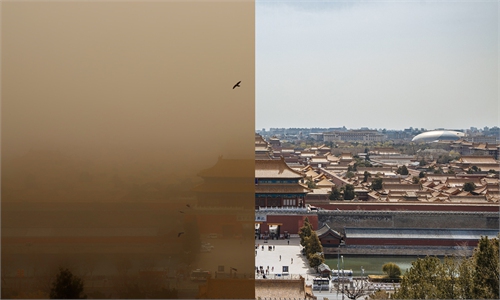
A girl in Beijing covers her face with a scarf during a sandstorm. A powerful sandstorm originally from Mongolia swept across much of northern China on Monday, creating the strongest and most extensive sandstorm in the country in a decade. Photo: cnsphoto
Beijing has vowed to step up efforts to improve its air quality after the Chinese capital experienced more than 20 days of pollution since February, which, according to experts, was mainly due to sand and drifting dust transported by strong cyclones this year.
Meteorologists said that sand and dust from neighboring Mongolia mainly contributed to the problem.
Beijing has had many polluted days since the beginning of spring in 2021, including the recurrence of heavy sandstorms on a scale that hasn't been seen for many years, said Mayor Chen Jining at a conference on Tuesday.
According to weather monitoring statistics, since February, the city has experienced a total of 23 days of pollution, with five of them being heavily or severely polluted. During the same period last year, there were only 10 polluted days, with three days being heavy or severe.
Meteorological experts said that the pollution had mainly been caused by sand and drifting dust from Mongolia and North China's Inner Mongolia Autonomous Region, with cyclones relatively stronger than those in previous years so that they can carry sand from long distances.
The geographical location at the downstream of Mongolia and its monsoon climate gives Beijing an additional pollution problem during the spring, besides winter pollution caused by burning coal for heat and summer pollution caused by pollutants like ozone, Zhang Mingying, a Beijing-based meteorologist, told the Global Times on Wednesday.
Wang Gengchen, a research fellow at the Institute of Atmospheric Physics of the Chinese Academy of Sciences, noted that emissions contributed relatively less to the city's pollution since February, while the sand pollution was the main cause.
"This year's stronger cyclone is able to suck a great volume of sand in Mongolia and other dust sources to a high altitude and transport it all the way to Beijing, without falling down halfway, which usually happened in past years," Wang told the Global Times on Wednesday.
Wang added that the backflow of the south wind had also brought floating dust back to Beijing before the dust had fully dissipated in the city, thus leading to hazy days after the sandstorm.
Beijing experienced "moderate pollution" during the daytime on Wednesday with an air quality index of 154 and PM10 being its main pollutant, according to the Beijing Ecological Environment Monitoring Center.
The air quality of the city was affected by dust from the southern area of Mongolia carried eastward by a westerly wind on Tuesday, said the center.
Meteorologist Zhang said that the dusty weather in Beijing had been greatly improved since 2000 due to the green controls that the city has been enhancing for years.
"There are almost no local sand sources in the region of Beijing, which is a great achievement for the city's pollution control work," Wang said.
Mayor Chen vowed further efforts to fight the city's pollution problems and dusty weather, which haven't been seen in many years, during the Tuesday conference. Chen served as China's minister of environmental protection from 2015 to 2017.
The Beijing municipal government in November 2020 launched an air pollution control campaign for autumn and winter, setting a target of controlling the average PM2.5 concentration to 45 micrograms per cubic meter and having no more than one day of heavy pollution during the fourth quarter.
It also set a target for January to March 2021 that limits the number of days of heavy pollution to three to nine days, which was expected to be moderately fulfilled, seen from the current statistics.

